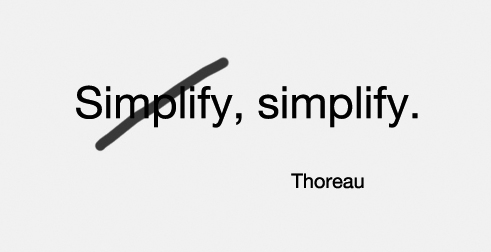Great Design Is Simple, That's Why It's So Hard

By Ken Peters
Johannes Kepler noted, “Nature loves simplicity…” Water does indeed flow down the path of least resistance. Human beings are 98% water, so perhaps it stands to reason that we, too, would naturally seek simplicity.
We live in a seemingly complex, often confusing world. Simplicity creates order, understanding and a sense of control. Design – across it’s many disciplines – is the science of simplification. Adolf Loos famously espoused, “Ornament is a crime.” Mies van der Rohe proclaimed, “Less is more.” Buckminster Fuller favored, “Doing more with less,” and Dieter Rams’ 10 Principles of Good Design dictate, “Less is better”. Without design, less would just be less. That's why the designer’s approach to minimalism is not merely visual style.
An awful lot of complex thinking goes into making things simple. Designing simplicity requires cutting to the heart of complexity; doing away with the superfluous and inefficient; clarifying, organizing, optimizing; pruning a thing to its purest form to function effortlessly and beautifully, while drawing forth meaning, metaphor and character. “The ability to simplify means to eliminate the unnecessary so that the necessary may speak.” ~ Hans Hofmann.
Charles Mingus observed, “Making the simple complicated is commonplace; making the complicated simple, awesomely simple, that’s creativity.” Minimalism is simple, that’s why it’s so hard. Even Picasso confessed, “I used to draw like Raphael, but it has taken me a whole lifetime to learn to draw like a child.”
Simple should not be mistaken for simplistic. Consider this simple, six word story by Ernest Hemingway: “For sale. Children's shoes. Never worn.” That’s the story in its entirety, but it’s clearly not the whole story. Those six simple words send the imagination careening. So, too, does a simple set of six 2x4 LEGO bricks which can be configured into 915, 103, 765 unique combinations.
Flights of imaginative fancy take wing with the simplest of beginnings. Give a child a cardboard box to play in and watch what happens. Give a musician a simple three-chord progression and you could end up with anything from Beethoven’s Pastoral Symphony to Richie Valens’ La Bamba to John Coltrane’s Lazy Bird to the Ramone’s Blitzkrieg Bop.
Things are rarely as complicated as they seem. Rubik’s Cube can always be solved within 25 turns, no matter how scrambled. The most prodigious prestidigitation is achieved with simple, subtle slight-of-hand. We often miss the obvious because we're confused into over-thinking. Good design cuts through confusion, which is why good design is good business.
Life is complicated enough consumers don’t need poorly designed products and services making it more difficult. Lexus’ GPS is notoriously convoluted yet Toyota engineers refused for years to simplify the design because they maintained users were operating it incompetently.
Conversely, simply type in a search term on Google and in a fraction of a second their algorithms solve an equation of more than 500 million variables to rank more than 8 billion web pages. For the end user, Toyota complicates a simple task while Google simplifies one of monumental complexity.
“Any intelligent fool can make things bigger, more complex, and more violent. It takes a touch of genius—and a lot of courage—to move in the opposite direction.” ~ E.F. Schumacker
Which direction is your brand moving? Do your products and services simplify or complicate life for consumers? Do you consistently deliver on the promise your brand makes? How convenient is the customer experience within your retail space; the social media space; on the phone; on your web site? How well do your products work? How simple is it for consumers to get support when they don’t? Design determines those answers.
Simplicity sells. With the launch of the first iPod Apple conveniently put “1000 songs in your pocket”, provided an elegant device on which to play them, and later, with the iTunes Store, an effortless system with which to preview and purchase them. Each element, from product to process, meticulously designed for simplicity. As of October 2011, 300 million iPods have been sold worldwide with more than 10 billion songs downloaded from the iTunes Store.
Give consumers simplicity. Design from their perspective outward. Think in terms of what problems you solve rather than what services you offer. Nature loves simplicity. Make people's lives simpler and they will naturally flow toward your brand.
___
Ken Peters is Co-founding Partner and Creative Director of Nocturnal Branding Studio, a full-service branding and design agency located in Phoenix, AZ. He's been known to design for everyone from Silicon Valley giants to start-up cat toy manufacturers. His work has garnered him everything from a host of awards to a grateful kiss on the cheek. He also makes a mean teriyaki chicken dish, but it hasn't earned any awards. To talk to Ken email him at: ken@nocturnaldesign.com
©Nocturnal Studio

